DIY mini greenhouse: materials and manufacturing methods
DIY mini greenhouse is the best opportunity to grow healthy and strong seedlings, which will become the basis of the future harvest. Every gardener will say that the main care for the plants does not begin when they have already been planted in the garden, but only when they begin to germinate, and it is at this time that they need to be provided comfortable conditions... A simple and convenient mini greenhouse will allow you to get a good harvest very early, and fresh vegetables and fruits will be on your table long before the main season. What is the best way to make such a greenhouse?
Content:
- Basic requirements for a mini-greenhouse on the site
- Options for the construction of frame greenhouses
- What can you fill the frame with?
- We build a mini-greenhouse with our own hands
- How to make a mini greenhouse out of unnecessary windows
Basic requirements for a mini-greenhouse on the site
Greenhouse - this is a light structure, most often a frame, which is installed to provide plants with heat and light, as well as to protect them from adverse external conditions. In early spring, the air is still quite cold, and there may be frosts on the soil that can completely destroy the entire future harvest.
The greenhouse receives the sun's rays, but does not let the cold air inside, creating good conditions for seedlings.
When building a greenhouse, you need to take care of meeting several basic requirements:
- She should let in as much light as possible so that the plants do not lack it. Poor lighting will cause any seedlings to start to stretch upward, the stems will become too long, thin and weak.
- She is required to have easy access to plants for glaze and weeding. This is an important condition, home-made designs are often reliable, but not very convenient for everyday plant care. In addition, the structure must provide air access for natural ventilation of the space.
- It must be strong. The frame structure has to withstand wind, rain, and sometimes sudden spring snowfall. All these tests she must easily tolerate, any damage to the frame or filling can lead to the death of plants.
- Aesthetics are also required from a mini greenhouse. This is also a rather important condition: the gardener should like his work, and a beautiful and comfortable greenhouse will be an excellent place for creativity and interesting agrotechnical experiments.
Options for the construction of frame greenhouses
The basis of any mini-greenhouse is the frame and the translucent filling of its cells. The frame can be made from several types of materials:
- Metal tubes. A common solution is a mini greenhouse with an aluminum or steel frame. The first option is much easier, so it will be easier to install and carry. Steel frames are cheaper, and if necessary, you can easily do it yourself using a welding machine.
- Wooden frame. This is a rarer solution, but it also occurs. Wooden frames require protection from decay so that they can be used for more than one season. Glazing is installed on a frame made of timber, and such a system will be very stable.So that the tree does not suffer from moisture, the base of the mini-greenhouse must be treated with antiseptic solutions and painted.
- Reinforced plastic greenhouses. If you had to change windows at home, and after that there are unnecessary frames, they should not be thrown away. They can be used to make a durable and inexpensive mini-greenhouse that is easy to use thanks to the fittings. From such frames, you can create very convenient structures for any plants.
What can you fill the frame with?
There are several options for translucent materials. Some of them can only be used in large greenhouses, and some are great for growing experiments. vegetables on your own site.
A mini glass greenhouse is a rather difficult option if there are no ready-made window frames that can be used as a frame.
Glass is a fragile material, but it has maximum transparency. If the glass is kept clean, plants will be constantly provided with the sunlight they need for life. Another common solution is film. It is easy to attach to any frame and is very inexpensive by itself. Polyethylene film does not allow air to pass through, so you will have to deal with the issue of ventilation of the space under it and prevention of too much humidity. The wrong conditions will affect the plants, so a reasonable installation option must be found for the film.
You can also choose as filling sheet plastic - polycarbonate.
In the construction of greenhouses, cast and cellular polycarbonate is used, the sheet thickness can be from 2 to 8 mm. This material has an important advantage: unlike glass, it does not break or shatter. In addition, it will be easy to bend, the polycarbonate sheet will be convenient to use in the construction of arched greenhouses and other similar structures.
The simplest solution is a plastic bottle greenhouse. They are made of transparent material, which can be used to assemble a simple and effective small structure. It is suitable, for example, for growing several small bushes, for which you do not need to build a separate greenhouse.
We build a mini-greenhouse with our own hands
Having considered all the options, you need to choose a solution that will be the most convenient and practical for your site. You can build a greenhouse in one day, one of the options is as follows:
- For the future mini-greenhouse, space is freed up and leveled on the site. Sizes can be any, it depends on the required number of seedlings.
- The greenhouse body is installed: a rectangular frame is hammered out of the boards, which is placed on the ground and partially dug into the ground. The height of the box should be about 60 cm.
- The bottom is covered with a drainage layer: for this you can use gravel, crushed stone or expanded clay. The thickness of the drainage layer should be about 2 cm. Then a layer of fertile soil up to half a meter thick is poured onto it. The soil can be immediately fertilized with those substances that are required for the successful cultivation of the selected crop.
- Thin pegs are installed on the corner sides of the body, to which the frame will be attached. You can use ordinary plastic pipes for it. They bend quite easily, withstand constant loads, are not afraid of corrosion, therefore they will become the most convenient solution for the construction of the frame. The pipes are bent and installed on pegs, the distance between adjacent arcs should not be more than 40 cm.
- A film is stretched and attached to the arcs of the frame. After that, you need to attach the upper frame element - a metal wire that will run along the entire length of the structure, pressing the film to the arcs.
There is another option for building a frame from scrap materials: you can take a simple water hose, into which strong willow rods are inserted.They easily bend to the desired arc shape, and the rubber hose will protect them from moisture and decay. Despite its simplicity, such a system can last more than one season in the country.
The greenhouse covered with plastic wrap can be used for planting any crops, for example, it will be convenient to hide under it from bad weather tomato seedlings.
One of the advantages is mobility - such a mini-greenhouse can be easily disassembled in a few minutes, moved to another place and reassembled.
It is necessary to moisten the soil in the inner space, and you can proceed to planting plants. Sometimes the box is supplied with a bottom: the box will be isolated from the main soil. This will make it easy to drag and drop it, but the plants may have too little land. In this case, the box must have a great depth.
How to make a mini greenhouse out of unnecessary windows
This is another greenhouse option that is suitable for light-loving plants. Such a box is made of boards and an old window frame or glass door, which for some reason has become unnecessary in the house.
The design is very simple: a wooden frame assembled from planks becomes its basis.
It is placed in the selected area, partially digging into the ground. A hinged window sash is attached to the side wall of the case. It should be easy to open and close.
The result is a durable and closed box on all sides, the interior of which will be very easily accessible. Inside, you can pour fertile soil and plant plants, or you can put ready-made pots or boxes with earth. This design has one drawback: the sun does not penetrate through the walls of the box, as a result, the daylight hours of the plants will be shorter than necessary.
You can make the frame of the box so that the glass cover will not be placed horizontally, but obliquely. This will allow for greater penetration of sunlight, and it will be easier to work with the greenhouse.
You can build a mini-greenhouse yourself in a few hours, and it will be used for more than one year in the future.
You can show your imagination: often gardeners build frames for greenhouses from literally any remnants of building materials that accumulate on the site after any major repairs. The built mini-greenhouse will be a shelter from the cold for many plants.
More information can be found in the video.



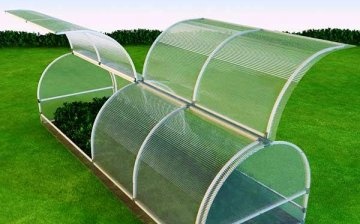
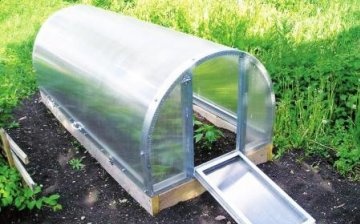
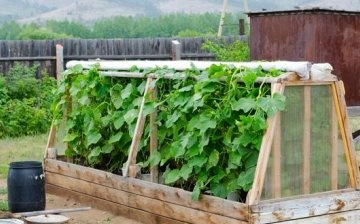
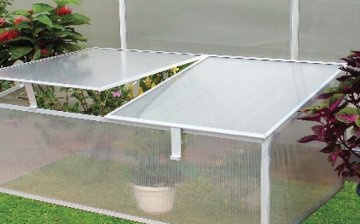
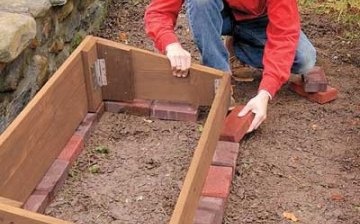







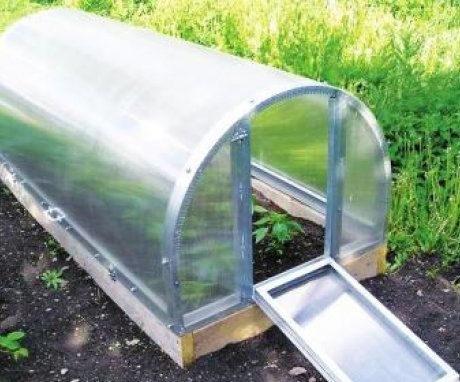
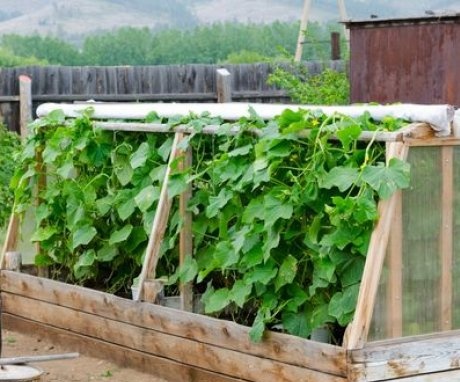
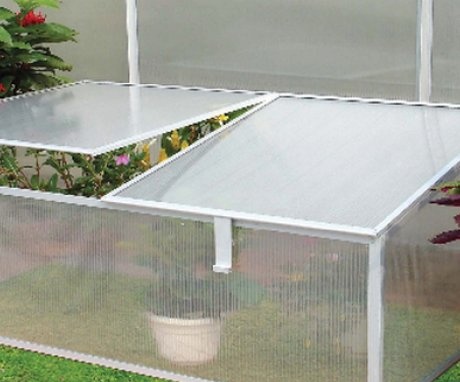
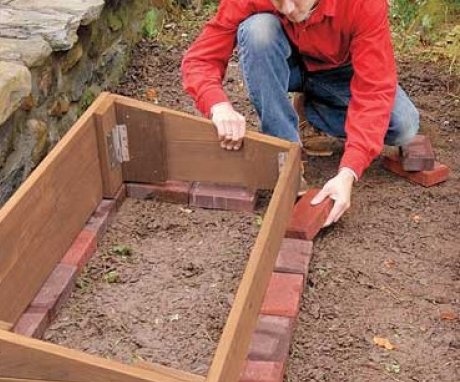
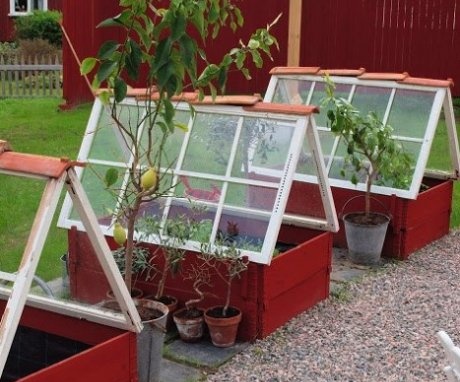
It is best to make greenhouses from a profile pipe and cover with polycarbonate. In such a greenhouse, polycarbonate will retain the heat that it received from the sun during the day, and the plants will not freeze at night.